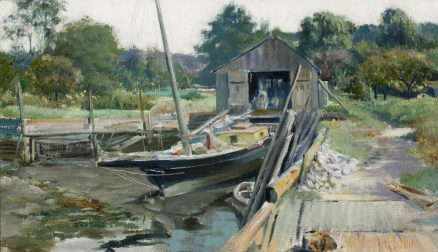- Categories
- Landscapes
- Zoom in on Artwork
- Print Page
- Email Page to Friend
Stranded on a muddy bank at low tide, a boat with its sails furled and its mast at a tilt forms the focus of Charles Corwin’s Evening at Bartow’s. Distinct notes of orange, red, green, and yellow on the vessel’s deck stand out in a composition otherwise saturated with blues, greens, and neutral tones. On the right, a path partly formed by rough planks leads the eye into the scene toward a modest weathered shed, its doors open to the light of a waning summer afternoon. Corwin’s loose, open brushwork complements the apparently uncomposed naturalism of the image, in which forms are arbitrarily cropped by the edges of the picture. Yet the composition is carefully structured, with a series of skewed diagonal lines—dominated by those of the canted mast and the upright timbers to the right of the boat—framing the view toward the shed.
Although the specific site pictured here is unidentified, Corwin likely found it in the coastal Northeast, where he painted during summers beginning in 1900. He showed the resulting landscapes at the Art Institute of Chicago over the following three years. This painting has been speculatively identified as the work entitled Evening at Bartow’s exhibited in the 1902 “Chicago and Vicinity” annual show. Corwin’s most important East Coast destination was the fishing town of Gloucester, Massachusetts, but titles of his extant works indicate that he also painted on the shoreline of Long Island, New York. Whether painting in such locales or closer to home in the Chicago region, the artist followed the contemporary trend toward informal landscape images offering intimate glimpses of accessible, ordinary locales. Evening at Bartow’s captures the quiet mood of an abandoned familiar spot without providing identifying geographic specifics, hinting at the artist’s personal experience of the setting.
Wendy Greenhouse, PhD
Donated by M. Christine Schwartz to The Richard H. Driehaus Museum, Chicago, Illinois, in 2022
